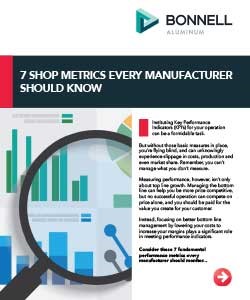blog & educational outreach

7 SHOP METRICS EVERY MANUFACTURER SHOULD KNOW

Instituting Key Performance Indicators (KPI’s) for your operation can be a formidable task.
But without those basic measures in place, you’re flying blind, and can unknowingly experience slippage in costs, production and even market share. Remember, you can’t manage what you don’t measure.
Measuring performance, however, isn’t only about top line growth. Managing the bottom line can help you be more price competitive, but no successful operation can compete on price alone, and you should be paid for the value you create for your customer.
Instead, focusing on better bottom line management by lowering your costs to increase your margins plays a significant role in meeting performance indicators.
Consider these 7 fundamental performance metrics every manufacturer should monitor...


THROUGHPUT
It’s likely that this basic indicator is already being tracked in your facility. If it isn’t, it is easy to start. Throughput is merely production over a specified time period.
If your facility produces units of finished or semi-finished goods, throughput is relatively simple to calculate. If you do not produce a finished product, you can simply substitute any other production indicator in its place. This could be lengths, pounds, or any other measure that you can track consistently.


INVENTORY TURN
For businesses that stock product, it’s important to know how often that inventory turns over. In this way you can determine issues with excess inventory, which should be a business expense. Space in your facility has a cost that can be measured, for example, in square footage. Turn can also indicate poor demand
planning.


CYCLE TIME
Regardless of whether you produce completed products or individual components of a product, you can (and should) measure the cycle time of both. Doing so allows you to gauge where efficiency can be gained for both the component and final product.


CAPACITY UTILIZATION
Knowing the percentage of production capacity in use allows you to maximize both your equipment usage and labor. This KPI is key in predicting lead times, the ability to take on new customer orders, and even predict when expansion may be necessary.


CHANGEOVER TIME
Often, time to switch tasks is not tracked in manufacturing. But breaking down steps and finding efficiencies is the path to profitability. In this case, facilities should count this lost time in order to manage change.


MACHINE DOWNTIME
Hand in hand with changeover time, machine downtime allows you to paint a picture about your output and may also point to problematic cells within your facility. This predictor is a balance between scheduled and unscheduled downtime and can help improve throughput.


DOWNTIME TO OPERATING TIME
Two factors that can be directly influenced in a manufacturing environment are machine time and labor time. Both need to be measured in order to squeeze more production and profitability through your business. Unplanned machine downtime can lead to higher labor costs, so tracking any downtime (as described above) can help identify lost productivity that could be improved.

